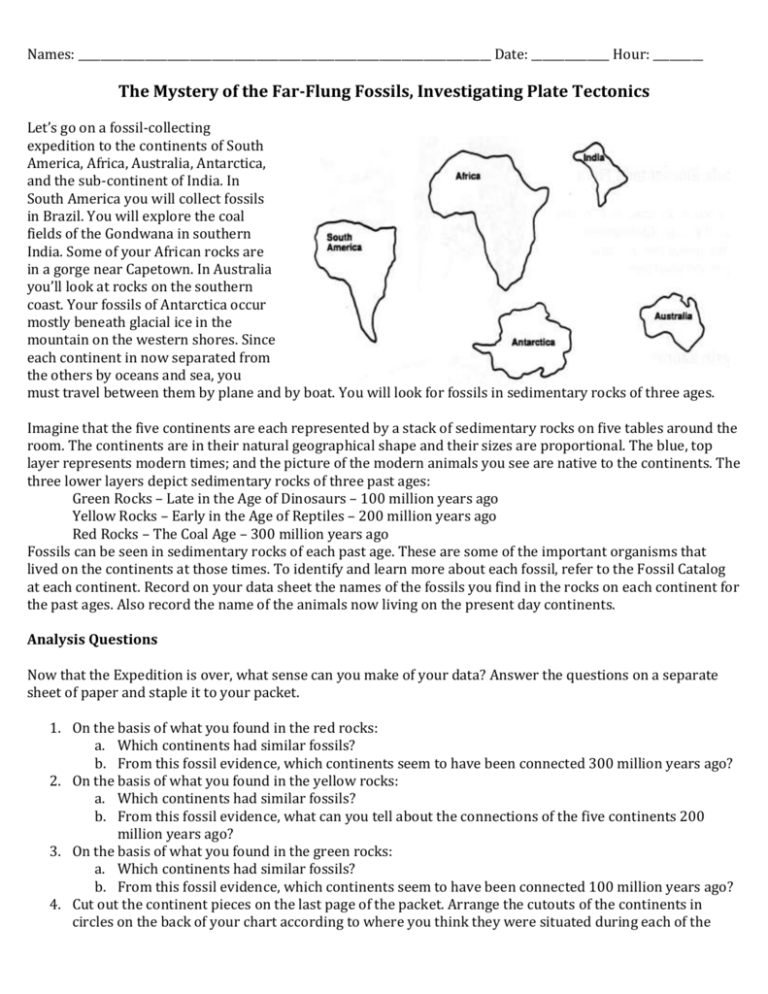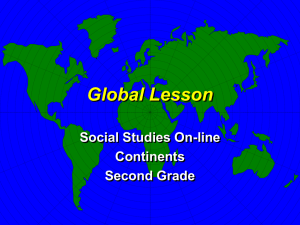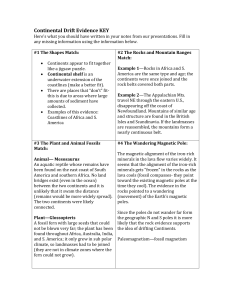Plate Tectonics: Fossil Evidence & Continental Drift Worksheet
advertisement

Names: __________________________________________________________________________ Date: ______________ Hour: _________ The Mystery of the Far-Flung Fossils, Investigating Plate Tectonics Let’s go on a fossil-collecting expedition to the continents of South America, Africa, Australia, Antarctica, and the sub-continent of India. In South America you will collect fossils in Brazil. You will explore the coal fields of the Gondwana in southern India. Some of your African rocks are in a gorge near Capetown. In Australia you’ll look at rocks on the southern coast. Your fossils of Antarctica occur mostly beneath glacial ice in the mountain on the western shores. Since each continent in now separated from the others by oceans and sea, you must travel between them by plane and by boat. You will look for fossils in sedimentary rocks of three ages. Imagine that the five continents are each represented by a stack of sedimentary rocks on five tables around the room. The continents are in their natural geographical shape and their sizes are proportional. The blue, top layer represents modern times; and the picture of the modern animals you see are native to the continents. The three lower layers depict sedimentary rocks of three past ages: Green Rocks – Late in the Age of Dinosaurs – 100 million years ago Yellow Rocks – Early in the Age of Reptiles – 200 million years ago Red Rocks – The Coal Age – 300 million years ago Fossils can be seen in sedimentary rocks of each past age. These are some of the important organisms that lived on the continents at those times. To identify and learn more about each fossil, refer to the Fossil Catalog at each continent. Record on your data sheet the names of the fossils you find in the rocks on each continent for the past ages. Also record the name of the animals now living on the present day continents. Analysis Questions Now that the Expedition is over, what sense can you make of your data? Answer the questions on a separate sheet of paper and staple it to your packet. 1. On the basis of what you found in the red rocks: a. Which continents had similar fossils? b. From this fossil evidence, which continents seem to have been connected 300 million years ago? 2. On the basis of what you found in the yellow rocks: a. Which continents had similar fossils? b. From this fossil evidence, what can you tell about the connections of the five continents 200 million years ago? 3. On the basis of what you found in the green rocks: a. Which continents had similar fossils? b. From this fossil evidence, which continents seem to have been connected 100 million years ago? 4. Cut out the continent pieces on the last page of the packet. Arrange the cutouts of the continents in circles on the back of your chart according to where you think they were situated during each of the three past ages. Arrange them also as they appear in the present. Explain your reasons for putting the continents together as you did for each time period. 5. Look at the black arrows on the red rocks of the continents (also see in the map below). The arrows represent grooves in the rocks. The grooves were carved by advancing continental glaciers about 300 million years ago. The arrows point in the direction the glaciers were moving. 6. 7. 8. 9. a. Suppose you were the first person to have found the glacial grooves in southeastern South America. From where would it seem the glacier came? b. Could the glacier have come from the ocean? Explain your answer. c. Why would the geologist who first found the glacial grooves in India be puzzled by the discovery? d. How might the idea of continental drift explain 300 million year old glacial grooves on four separate southern continents? e. Where was the probable spreading center of the glaciers? Make an “X” to mark this location on the map above. f. Where on the surface of the earth was the probably location of the “X” 300 million years ago? (Remember that a continental glacier tends to move out and away from its center, the North or South Pole – like a spreading mass of bread dough.) g. Where would you look for glacial grooves in the 300 million year old rock of Antarctica? Draw arrows where you would expect to find glacial grooves in Antarctica on the map above. Two species of living earthworms in the soils of southern South America and Africa were found to be very closely related (members of the same genus). Also, two species of living earthworms in soils of southern India and southern Australia were found to be very closely related (members of the same genus). How was the theory of continental drift strengthened by discoveries of closely related earthworms on widely separated continents? Examine the mammal pictures on the continents of South America, Africa, India, and Australia. These living animals are native on their continents. Each eats insects, and is a major ant/termite eater among all mammals there. Each species belongs to a different order of mammals. These four mammals are very distantly related, even though each is highly specialized for eating ants and/or termites. Explain in terms of continental drift and evolution how four very different kinds of ant/termite eaters could occur in India, Africa, South America, and Australia. (Remember the Age of Mammals began on earth after Dinosaurs became extinct about 65 million years ago). List as many pieces of evidence as you can to support the theory of continental drift. Why do you think it is so difficult for some people to accept the idea of continental drift? Data Sheet Fossils and Living Animals Found on the Five Continents Continent Time Present Day (blue) 100 million years ago (green) 200 million years ago (yellow) 300 million years ago (red) South America Africa India Australia Antarctica Explanation: Southern Hemisphere (Present) Southern Hemisphere (200 million years ago) Explanation: Southern Hemisphere (100 million years ago) Explanation: Southern Hemisphere (300 million years ago) Explanation:










